Different Species
There are many different types of penguins. Each and everyone of them are unique. If you try to count all the species, there would probably be 17 in all. Some people think that there are more than 17 because some penguins have different names. Like, the "Blue penguin" is also known as the "Little pengiun," "Little Blue penguin" and the "Fairy penguin."
These are all the different species:
African penguins Adelie penguins
Chinstrap penguins
Emperor penguins
Erect-crested penguins
Fiordland penguins
Galapagos penguins
Gentoo penguins
Humboldt penguins
King penguins
Little (Blue, Fairy or Little Blue) penguins
Macaroni penguins
Magellanic penguins
Rockhopper penguins
Royal penguins
Snares penguins
Yellow-eyed penguins
These are all the different species:
African penguins Adelie penguins
Chinstrap penguins
Emperor penguins
Erect-crested penguins
Fiordland penguins
Galapagos penguins
Gentoo penguins
Humboldt penguins
King penguins
Little (Blue, Fairy or Little Blue) penguins
Macaroni penguins
Magellanic penguins
Rockhopper penguins
Royal penguins
Snares penguins
Yellow-eyed penguins
Where do you find penguins?
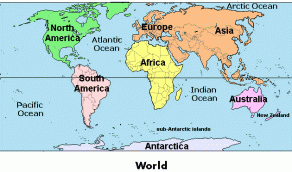
Penguins can be found in many different parts/habitats of the world. From the freezing cold Antartica, to the warm, sandy beaches of Australia. From the rough, rocky coasts of South America to the coasts of New Zealand. Penguins live in more habitats than any other animal in the world. Here are 15 different species that live around the world....
PENGUINS LIVING IN ANTARTICA AND SUB-ANTARTIC ISLANDS
Emperor Penguins
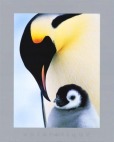
Emperor penguins are the largest penguins with a height of 45 inches (115 centimeters). Some Emperor penguins can grow to 1.1 meters or 3 feet 7 tall! Once, an Emperor penguin grew up to 4 feet!
However, emperor penguins are the only penguins that breed in the winter. They make their homes on thick ice in Antartica using their dense feathers, blubber and slow movements to keep them warm. Emperor penguins usually dive to about 165 feet (50 meters), but if they want, can dive up to 820 feet (250 meters). They can stay underwater to about 18 minutes without needing to come to the surface for air.
However, emperor penguins are the only penguins that breed in the winter. They make their homes on thick ice in Antartica using their dense feathers, blubber and slow movements to keep them warm. Emperor penguins usually dive to about 165 feet (50 meters), but if they want, can dive up to 820 feet (250 meters). They can stay underwater to about 18 minutes without needing to come to the surface for air.
Adelie Penguins
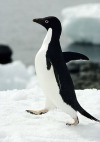
Adelie Penguins usually have a height of 27.5 inches (70 centimeters). They nest in big, noisy colonies. The females usually lays two eggs, so that each parent can incubate (sit on) it. The egg that is first hatched, gets all the food first-the second hatched must wait until it's older sibling moves off the nest, for its food.
The parents leave the nesting grounds after the chicks grow up. While they are away, they hunt for food in the freezing ocean and they molt (old feathers fall off, new feathers grow back) on a glacier (ice floes) during the whole winter.
The parents leave the nesting grounds after the chicks grow up. While they are away, they hunt for food in the freezing ocean and they molt (old feathers fall off, new feathers grow back) on a glacier (ice floes) during the whole winter.
Gentoo Penguins
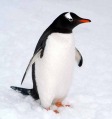
Gentoo peguins can swim up to 27 miles (45 kilometers) an hour, then they shoot up above the water to get a breath of air.
Gentoo penguins are usually 29-31 inches (75-81 cetimeters) tall. They weigh about 13 pounds. Gentoo penguins have wide white strips over their head, so they are easy to identify. For their nests, they pile stones, grass and sticks creating a circular shape. During the autumn Gentoo penguins molt, waiting for the gelid winter to come...
Gentoo penguins are usually 29-31 inches (75-81 cetimeters) tall. They weigh about 13 pounds. Gentoo penguins have wide white strips over their head, so they are easy to identify. For their nests, they pile stones, grass and sticks creating a circular shape. During the autumn Gentoo penguins molt, waiting for the gelid winter to come...
King Penguins
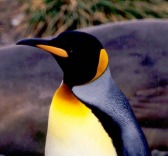
SWOOSH! A king penguin slides on its belly across a thin piece of ice. This is what they call "tobogganing" because it is silimlar to a person with a toboggan. Since penguins have short legs, it's easier for them to slide than to walk.
King penguins are the second-largest penguins in the world. Their size usually is 36 inches (91 centimeters).
Sometimes, for food, they must dive 165 feet (50 meters) before any food may show up. They must dive deeper in the winter. King penguins feed their chicks lots of food to prepare for the winter. The funny thing is, the chicks grow into big, fluffy, brown balls! Some of the chicks are so big, that they make their parents look small.
King penguins are the second-largest penguins in the world. Their size usually is 36 inches (91 centimeters).
Sometimes, for food, they must dive 165 feet (50 meters) before any food may show up. They must dive deeper in the winter. King penguins feed their chicks lots of food to prepare for the winter. The funny thing is, the chicks grow into big, fluffy, brown balls! Some of the chicks are so big, that they make their parents look small.
Macaroni Penguins
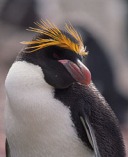
How do you think Macaroni Penguins got their name? Well, there were these English explorers who found out about the macaroni penguin, and because of the vivid, orange head crests on their head, the explorers thought that it looked like the hats that fashionable men wear in England who were known as "Macaronis". So, they kept on calling the penguin, Macaroni," and the name stuck.
The Macaroni penguins have a height of 28 inches (71 centimeters).
Did you know that, some colonies have more than 1 million penguins so the smell and noise is stronger. Sometimes, you can smell them from 5 miles (8 kilometers)!
The Macaroni penguins have a height of 28 inches (71 centimeters).
Did you know that, some colonies have more than 1 million penguins so the smell and noise is stronger. Sometimes, you can smell them from 5 miles (8 kilometers)!
Chinstrap Penguins
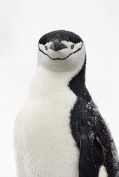
Chinstrap penguins are very numerous. It is esimated that there are 12 to 13 million located on the barren islands.
They have a height of 26-30 inches (68-77 centimeters).
Chinstrap penguins got their names because of the little, black line of feathers in their face.
In the summer, they breed and live in large colonies near the Gentoo and Adelie penguins. Chinstrap penguins have nests of pebbles. Females lay 2 eggs at a time. The eggs hatch after about 15 to 33 days. The chicks must stay in the nest until they are 20 to 30 days old.
They have a height of 26-30 inches (68-77 centimeters).
Chinstrap penguins got their names because of the little, black line of feathers in their face.
In the summer, they breed and live in large colonies near the Gentoo and Adelie penguins. Chinstrap penguins have nests of pebbles. Females lay 2 eggs at a time. The eggs hatch after about 15 to 33 days. The chicks must stay in the nest until they are 20 to 30 days old.
PENGUINS LIVING IN SOUTH AMERICA
Galapagos Penguins
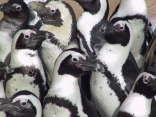
Galapagos penguins are the smallest penguins of the "warm weather" penguins. It's height is only 19-21 inches (48-53 centimeters)! That is very small for a penguin.
Instead of living in big colonies like all the other penguins, they live in small groups with their mate in pairs of 2 or 3. They stay in the same place for summer and winter. There is a lot of food, so a female may be able to lay 3 clutches of eggs! The population had gone down once because there wasn't enough sardines and mullet, so being able to lay 3 clutches of eggs is helping the population rise. Galapagos penguins build their nests on hardened lava, also known as magma.
Instead of living in big colonies like all the other penguins, they live in small groups with their mate in pairs of 2 or 3. They stay in the same place for summer and winter. There is a lot of food, so a female may be able to lay 3 clutches of eggs! The population had gone down once because there wasn't enough sardines and mullet, so being able to lay 3 clutches of eggs is helping the population rise. Galapagos penguins build their nests on hardened lava, also known as magma.
Humboldt Penguins
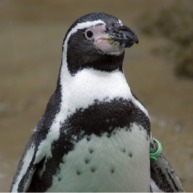
Humboldt penguins got their names from the European explorer, Humboldt, who first found them.
They usually are 17 inches (60 centimeters). They weigh 6.5-11 pounds (3 to 5 kilograms).
Humbolt penguins live in small groups off the coasts of Peru and Chile. They make their nests out of large, hardened piles of guano. Guano is bird droppings. Sadly, some people collected guano and found out that it was very good fertilizer. So now, Humboldt penguins can't use guano anymore; there's not enough. Instead, they use caves so the hungry gulls and skuas cannot eat the chicks.
The male will pick out a good place for a nest; he will court (try and get attention to) a female, then start bowing and bobbing his head to see if she would like him. If she does, then the pair will mate for life.
Sometimes, the parents has to travel up to 45 miles (75 kilometers) just to find food for their chicks. If the chicks grow quickly, they'll be on their own after 3 months.
They usually are 17 inches (60 centimeters). They weigh 6.5-11 pounds (3 to 5 kilograms).
Humbolt penguins live in small groups off the coasts of Peru and Chile. They make their nests out of large, hardened piles of guano. Guano is bird droppings. Sadly, some people collected guano and found out that it was very good fertilizer. So now, Humboldt penguins can't use guano anymore; there's not enough. Instead, they use caves so the hungry gulls and skuas cannot eat the chicks.
The male will pick out a good place for a nest; he will court (try and get attention to) a female, then start bowing and bobbing his head to see if she would like him. If she does, then the pair will mate for life.
Sometimes, the parents has to travel up to 45 miles (75 kilometers) just to find food for their chicks. If the chicks grow quickly, they'll be on their own after 3 months.
Magellanic Penguins
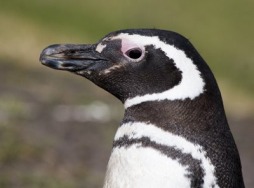
Magellanic pengiuns were named after Ferdinand Magellan; he was the first one to find magellanic pengiuns in 1519.
Magellanic pengiuns make many different sounds like braying, bleating and cackling. It's really easy to hear a colony of megellanic penguins. The breeding colony at Punta Tomba has more than 1 million megellanic penguins! They nest on grassy slopes and in open woodland. They return to their breeding grounds at around September which is the beginning of South America's spring.
They have black, scattered spots on their chest, a long line of feathers shaped like a backwards shoe horn, on the belly and a wide, gray strip at the neck.
Their height is 17 inches (60 centimeters).
Magellanic pengiuns make many different sounds like braying, bleating and cackling. It's really easy to hear a colony of megellanic penguins. The breeding colony at Punta Tomba has more than 1 million megellanic penguins! They nest on grassy slopes and in open woodland. They return to their breeding grounds at around September which is the beginning of South America's spring.
They have black, scattered spots on their chest, a long line of feathers shaped like a backwards shoe horn, on the belly and a wide, gray strip at the neck.
Their height is 17 inches (60 centimeters).
Rockhopper Penguins

Rockhopper penguins have the same "yellow crest" as the macaroni pengiuns. I think rockhopper penguins were named "rockhopper" because they have an unsual talent of jumping. They usually hop to their nesting areas with both feet together. When they put both feet together, they are able to jump 4-5 feet! However, it is easier for a rockhopper penguin to hop, than to waddle and slide, because of the jagged, wide rocks in their habitat. When a group of rockhopper penguins reach an extra steep rock, they secure their beak in the rock and dig a hole into the rock with their toes to keep themself from falling.
Rockhopper penguins build their nests at the top of cliffs. The deep caves helps the chicks to be safe from the gulls and skuas.
The most colorful penguins in Falkland Islands and islands near the coast of South America are rockhopper penguins with their bright red eyes, orange beaks, and small, colorful feathers at the top of the head.
Baby rockhopper penguins are born in November spending 3 weeks in cozy nests before joining a little group of other young penguins. They grow their feathers in March, so by that time, it's almost time for South America's winter.
Rockhopper penguins build their nests at the top of cliffs. The deep caves helps the chicks to be safe from the gulls and skuas.
The most colorful penguins in Falkland Islands and islands near the coast of South America are rockhopper penguins with their bright red eyes, orange beaks, and small, colorful feathers at the top of the head.
Baby rockhopper penguins are born in November spending 3 weeks in cozy nests before joining a little group of other young penguins. They grow their feathers in March, so by that time, it's almost time for South America's winter.
Little/Blue/Fairy/Little Blue Penguin
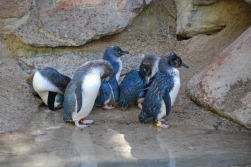
The little penguin is the smallest penguin in the world. That is why some people call them "fairy" penguins because faries are very small. They are 15-17 inches (40-45 centimeters).
When a male wants to mate, he raises up his head and flippers upward then starts to sing a song. It's not really a song; it is a loud braying sound. If a female penguin likes him, they build a nest together. Little penguins make their nests underground. Sometimes, little penguins may build their nests under a building, between the ties of railway tracks, or even in a stack a lumber. The female lays eggs, later on.
For food, the little pengiun eat fishes, octopuses, squids and tiny crustaceans (lobsters, crabs, shrimps etc. are custaceans). Little penguins can dive to about 226 feet (69 meters)!
When a male wants to mate, he raises up his head and flippers upward then starts to sing a song. It's not really a song; it is a loud braying sound. If a female penguin likes him, they build a nest together. Little penguins make their nests underground. Sometimes, little penguins may build their nests under a building, between the ties of railway tracks, or even in a stack a lumber. The female lays eggs, later on.
For food, the little pengiun eat fishes, octopuses, squids and tiny crustaceans (lobsters, crabs, shrimps etc. are custaceans). Little penguins can dive to about 226 feet (69 meters)!
PENGUINS LIVING IN AUSTRALIA AND NEW ZEALAND
Yellow-eyed Penguins
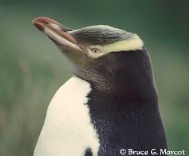
Yellow-eyed penguins have yellow feathers all around their faces. They are 21 inches (65 centimeters).
Yellow-eyed penguins eat cod, siversides, opal fish and arrow squid. They dive for food in groups of 2-3, including other penguins.
Breeding season is in August. The males show off by flashing the yellow stripes on their heads while bowing to the females. Once a couple gets together, they raise their chicks peacefully.
Living away from other penguins is what yellow-eyed penguins like to do. They like living in forests and grassy slopes near the ocean. Most of them live in New Zealand, Aukland, Campbell, Stewert and South Islands.
Yellow-eyed penguins eat cod, siversides, opal fish and arrow squid. They dive for food in groups of 2-3, including other penguins.
Breeding season is in August. The males show off by flashing the yellow stripes on their heads while bowing to the females. Once a couple gets together, they raise their chicks peacefully.
Living away from other penguins is what yellow-eyed penguins like to do. They like living in forests and grassy slopes near the ocean. Most of them live in New Zealand, Aukland, Campbell, Stewert and South Islands.
Fiordland Penguins
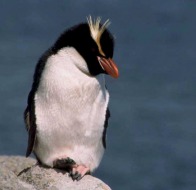
Fiordland Penguins have a long crest of bright yellow feathers starting from the bill and coming back behind their eyes. They are also known as the "Fiordland crested penguins" and the "Thick-billed penguins". Fiordland penguins are shy and timid creatures that live on the west and southwest of New Zealand, also including two offshore islands of Stewart and Solander.
The nesting areas are difficult to see because of thick vegetation. Fiordland penguins make their nest in the soft ground. The estimation of the total population was fewer than 1,000 breeding pairs. When the female penguin gets a egg, the egg is kept warm for thirty to thirty-six days with the two parents taking care of it in turns of long five to twelve day shifts. The female brings food while the egg hatches and the male stays with the chick for two to three weeks. The chicks get their adult feathers and go to sea in about seventy-five days.
The nesting areas are difficult to see because of thick vegetation. Fiordland penguins make their nest in the soft ground. The estimation of the total population was fewer than 1,000 breeding pairs. When the female penguin gets a egg, the egg is kept warm for thirty to thirty-six days with the two parents taking care of it in turns of long five to twelve day shifts. The female brings food while the egg hatches and the male stays with the chick for two to three weeks. The chicks get their adult feathers and go to sea in about seventy-five days.
Erect-crested Penguins
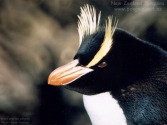
Erect-crested penguins have long, straight yellow feathers at the side of their head. They can move them up and down, unlike other crested penguins. They have a height of 25-27 inches (63-68 centimeters). Erect-crested penguins eat fish and squid.
Nests are made out of stones and mud. The female lays 2 eggs, but usually only 1 hatches. A good nesting site is hard to find, so penguins have to fight for one.
Before molting, erect-crested penguins must eat a lot because they are not allowed to eat while molting.
Nests are made out of stones and mud. The female lays 2 eggs, but usually only 1 hatches. A good nesting site is hard to find, so penguins have to fight for one.
Before molting, erect-crested penguins must eat a lot because they are not allowed to eat while molting.
PENGUINS LIVING IN AFRICA
African Penguins
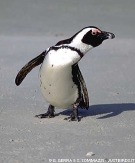
African penguins sound like donkeys when they speak. Sometimes, african penguins can be called "Jackass penguins."Jackass" is another word for a donkey. But, when the parents are ready to feed the chick, it croons softly. In water, african penguins communicate differently. African pengiuns are the only penguins that live close to Africa.
African penguins eat sardines, anchovies and squid. They stay in the cool water for most of the day to avoid the sun's hot rays.
For nests, african penguins scratch a small nest under a rock of bush. But the bad thing is, unfortunately, bushes aren't very safe from skuas and gulls, so about every year, at least one african penguin is eaten.
African penguins eat sardines, anchovies and squid. They stay in the cool water for most of the day to avoid the sun's hot rays.
For nests, african penguins scratch a small nest under a rock of bush. But the bad thing is, unfortunately, bushes aren't very safe from skuas and gulls, so about every year, at least one african penguin is eaten.

